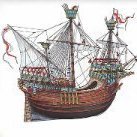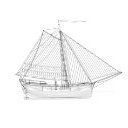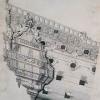
Roger Pellett
-
Posts
4,519 -
Joined
-
Last visited
Reputation Activity
-
 Roger Pellett got a reaction from Glen McGuire in The San Marco mosaic ship c. 1150 by Louie da fly - FINISHED - 1:75
Roger Pellett got a reaction from Glen McGuire in The San Marco mosaic ship c. 1150 by Louie da fly - FINISHED - 1:75
Steven,
Great job! 1100’s to 1400’s is a long time by modern standards but perhaps not so long for the ancients; particularly conservative mariners. Anyhow, you can really see how this vessel from the 1100’s could have evolved into the Carrack of the 1400’s. Every time that I look at your model with the braces to the stem the characteristic diagonal planking of the bows of the Carricks makes sense.
Roger
-
 Roger Pellett got a reaction from Ferrus Manus in The San Marco mosaic ship c. 1150 by Louie da fly - FINISHED - 1:75
Roger Pellett got a reaction from Ferrus Manus in The San Marco mosaic ship c. 1150 by Louie da fly - FINISHED - 1:75
Steven,
Great job! 1100’s to 1400’s is a long time by modern standards but perhaps not so long for the ancients; particularly conservative mariners. Anyhow, you can really see how this vessel from the 1100’s could have evolved into the Carrack of the 1400’s. Every time that I look at your model with the braces to the stem the characteristic diagonal planking of the bows of the Carricks makes sense.
Roger
-
 Roger Pellett got a reaction from BETAQDAVE in drilling hole through wire
Roger Pellett got a reaction from BETAQDAVE in drilling hole through wire
I’m used to the Real Rogers Drill bitts and still have my Rogers stand. The replacement drills on order are Chicago Latrobe, supposed to be made in the USA. We’ll see.
Roger
-
 Roger Pellett got a reaction from Some Idea in drilling hole through wire
Roger Pellett got a reaction from Some Idea in drilling hole through wire
I like to drill with conventional HSS Drill bitts. I use my Sherline Lathe fitted with a milling column and sensitive drilling attachment. This allows me to clamp the object being drilled in a vise secured to the lathe cross slide to accurately position the drill bit over the center punched mark. I do not have the touch for using carbide drill bitts. They usually shatter on the first hole.
My current project involves cross drilling a .020” hole through a 1/16” brass tube. I need 48 of these tiny pieces. I decided to drill them as a row of holes along the tube, the individual pieces to be cut apart later. I filed a flat on the top of the tube and center punched each hole location. I had bought a brand new set 61-80 Gyros Brand wire sized drills from Amazon. I chucked the correct sized drill bitt and started drilling. Each of the first 8 holes took forever even with considerable pressure on the drill. Different lubricants and drill speeds made no difference. Frustrated, I rummaged around my tool supplies and found a similar sized no-named drill bitt bought long ago. It drilled through each hole like it was butter.
The Gyros drills heavily promoted by Amazon are Chinese Imports. I just ordered a set of Made in USA replacements.
Roger
-
 Roger Pellett reacted to Keith Black in USS Tennessee 1869 by Keith Black - scale 1:120 - Wood Hull Screw Frigate - ex Madawaska 1865
Roger Pellett reacted to Keith Black in USS Tennessee 1869 by Keith Black - scale 1:120 - Wood Hull Screw Frigate - ex Madawaska 1865
Thank you @Cathead @Roger Pellett @mcb @AJohnson @wefalck @mbp521 @Rick310 @mtaylor @BANYAN @Glen McGuire @Knocklouder @Bob Cleek @My Fathers Son for your Holiday wishes, kind thoughts, and support and thank you to Andy, Siggi, Tom, Dave, and Phil for the likes.
It's been busy times at the worktable, I got the gaff rigged and the lifts around the foremast rigged.
The blocks at the base of the mast sit at the edge of a diameter the size of a US penny, .75 inches.
The distance between the block's inside edge and the mast is .2 inches and .1 inches between the belaying pins and block's inside edge. The block (gaff lift) between the companionway railing is so tight I had to glue the block's sheave side perpendicular to the mast and once rigged, it was twisted 90 degrees to line up correctly.
It's kinda like SIB work without the bottle, it's all done with tweezers. The main problem is the thread wants to hang up on everything and the belaying pins are easily bent out of position. I really don't care how long it takes to preform a task at this scale as long as I'm successful. Sometimes the result is more suggestion than 100% accuracy and that'll just have to be okay.
I worked Christmas Eve and most of Christmas Day.....'the blocks were hung by the foremast with care in hopes that'
Thank you for following along and smooth sailing to all throughout the New Year.
Keith
-
 Roger Pellett got a reaction from mtaylor in The San Marco mosaic ship c. 1150 by Louie da fly - FINISHED - 1:75
Roger Pellett got a reaction from mtaylor in The San Marco mosaic ship c. 1150 by Louie da fly - FINISHED - 1:75
Steven,
Great job! 1100’s to 1400’s is a long time by modern standards but perhaps not so long for the ancients; particularly conservative mariners. Anyhow, you can really see how this vessel from the 1100’s could have evolved into the Carrack of the 1400’s. Every time that I look at your model with the braces to the stem the characteristic diagonal planking of the bows of the Carricks makes sense.
Roger
-
 Roger Pellett reacted to Jond in Harvard 1926 by Jond - FINISHED - 1:96 - early steel hull beam trawler by Rice Bros
Roger Pellett reacted to Jond in Harvard 1926 by Jond - FINISHED - 1:96 - early steel hull beam trawler by Rice Bros
8 progress on the hull
Just a few bits of progress heading to the end of the year. I need to complete the stern and bow and then with a sub deck in place get the bulwarks done.
1 here I am building up the fantail using 1/64-inch plywood.
2 as we see clamping is tricky.
3 here I am building up the bow. I have chosen to follow the photos of the real Harvard at launch.
4 here is the Erik Ronnberg bow. Note the rounded affect. I like the wood deck insert but do not follow this curved profile.
5 here we see Harvard being launched and the fore deck is clearly as high as a man. A second meaning is there is clearly room for the crew area under the foredeck. The design drawing I have varies a bit but includes three portholes for three births in this area. As I mentioned before, I was not happy with my first rudder assembly as it ended up off center. This new set up used the aluminum foil to raise the little tube gudgeons and rudder hopefully to meet the centerline of the post.
6 here is the set up. It came out better, but still not on center. I may go one more time to try to get this right. Now time for the sub deck and bulwarks. As I shared before I goofed by making the bulkheads too high in such a small model. I roughed them down and to recover and decided to cheat. I added a 1/64 plywood sub deck to mitigate the issue.
7 here we are gluing down the plywood sub deck.
8 in this view I am gluing on the reraised bulwarks to meet the profile. And here are two photos for the xmas progress.
9, 10 the little wood blocks are still mock ups of configurations from different sources, since I have yet to find good photos of the completed vessel. I am still looking. I also have confirmed in the photos, but not the drawing, that there was a breakwater across the top of the fore deck to hold back water from coming on board. The question is, was that installed when built or added later. More on that subject next time Happy Holidays
-
 Roger Pellett reacted to Snug Harbor Johnny in Gorch Fock I 1933 by Snug Harbor Johnny - 1:100 - RESTORATION
Roger Pellett reacted to Snug Harbor Johnny in Gorch Fock I 1933 by Snug Harbor Johnny - 1:100 - RESTORATION
A ship in a bottle I made over 50 years ago was mentioned in another thread, but I could not provide a picture because it's whereabouts was unknown. 'Seems it survived a couple moves with my Mom, and then was somewhere in my brother's house ... and he finally found it and I received it back when visiting yesterday (Christmas Eve). I didn't know much about proper rigging at the time, but its not bad for a first exercise. A better version is on my 'bucket list' now. I'll have to find 'just the right' bottle - high and narrow on its side - and this is another thing to look for in the many antique sellers to be found in SE Pennsylvania.
The wavy glass distorts things a bit (typical), and next time I should have 3 masts (barque rigged) - like the GF or Big T in her later years. Notes to self; have the back stays go to the masts (not the yards ... although that made it easier to untwist the masts once in the bottle, as those lines pass over the deck to the corresponding hole in the opposite bulwark ), add fine ratlines by gluing, paint hull, rig braces to beads on the forestays.
The masts were not hinged, but just fit into shallow holes in deck. Several dabs of slow curing epoxy were put on the inside of the bottle, and the collapsed vessel maneuvered with long tweezers to that place and allowed to completely cure. Then a dab of epoxy was placed in the holes for the masts (with a long wire as an applicator). The forestays attached to the fore mast had long ends at that time and came out the neck of the bottle. Long tweezers helped grip the base of the for mast as the stay lines were pulled to stand the masts up - the 2nd mast just following the first. The tweezers pushed the mast bottoms into the shallow holes and they were allowed to completely cure.
The fore stays did not go through holes in the bowsprit, so each one (in turn, from back to front) was positioned on the bowsprit with tweezers - and another tweezer end applied a dab of '3 minute' epoxy where the line was held on the underside of the bowsprit. After setting, another line was done (the line ends still coming out of the bottle) until all were done. Then after curing, a long X-Acto trimmed the lines at the bowsprit. Then a cork was jammed into the bottle neck.
Additional notes to self - work out making the masts hinged, because that will be less harrowing that 'planting' the mast ends into holes like I did (I recall that it was difficult to manage). I've seen hinges used on other ship-in-bottle MSW threads. Also, having the fore-most stays passing through holes in the bowsprit will be much easier to glue later.
Merry Christmas (or Festivus) and a Happy New Year in you shipyards, mates ! Johnny
-
 Roger Pellett got a reaction from FriedClams in USS Tennessee 1869 by Keith Black - scale 1:120 - Wood Hull Screw Frigate - ex Madawaska 1865
Roger Pellett got a reaction from FriedClams in USS Tennessee 1869 by Keith Black - scale 1:120 - Wood Hull Screw Frigate - ex Madawaska 1865
Great to see you back in the workshop again Keith.
Roger
-
 Roger Pellett got a reaction from Hubac's Historian in TITANIC by Force9 – Trumpeter - 1/200 - PLASTIC - White Star Liner
Roger Pellett got a reaction from Hubac's Historian in TITANIC by Force9 – Trumpeter - 1/200 - PLASTIC - White Star Liner
Evan,
Glad you’re enjoying the book. Jack Woodward taught Marine Engineering courses at the University of Michigan when I was a student there. As Naval Architecture and Marine Engineering was a very small Department in a large University we came to know our professors personally and he was a great teacher. After Retiring, I wrote a monograph analyzing the 1896 era steam propulsion plant of the SS Meteor, the last of 44 Whaleback type ships once built in the Duluth MN, Superior, WI harbor. Woodward generously agreed to review the monograph for me before it was published by Superior Public Museums, the museum ship’s manager.
I have never met Garzke but I did write a review of the book for the Nautical Research Journal and corresponded with him via email regarding rivet strength. He concluded that the ship was just traveling too fast for the conditions. If you or your daughter would like a copy of his email to me send me a PM.
Roger
-
 Roger Pellett got a reaction from Bob Cleek in SS Blagoev ex-Songa 1921 by Valeriy V - FINISHED - scale 1:100 - Soviet Union
Roger Pellett got a reaction from Bob Cleek in SS Blagoev ex-Songa 1921 by Valeriy V - FINISHED - scale 1:100 - Soviet Union
I know that this is picky but correct terminology can sometimes help to understand what one is looking at.
The photo in post #157 above does not show “Rivet Heads.” These are the “points” of the rivets (the end of the rivet without the head) that have been “closed” hammered while hot to fill the slightly tapered hole in the shell plating. The actual trapezoidal shaped rivet head is on the inside of the shell plating.
Roger
-
 Roger Pellett got a reaction from Glen McGuire in USS Tennessee 1869 by Keith Black - scale 1:120 - Wood Hull Screw Frigate - ex Madawaska 1865
Roger Pellett got a reaction from Glen McGuire in USS Tennessee 1869 by Keith Black - scale 1:120 - Wood Hull Screw Frigate - ex Madawaska 1865
Great to see you back in the workshop again Keith.
Roger
-
 Roger Pellett reacted to wefalck in USS Tennessee 1869 by Keith Black - scale 1:120 - Wood Hull Screw Frigate - ex Madawaska 1865
Roger Pellett reacted to wefalck in USS Tennessee 1869 by Keith Black - scale 1:120 - Wood Hull Screw Frigate - ex Madawaska 1865
Goog luck witht he shrouds/ratlines. It's not as bad as it seems, when approached systematically. Tune into some nice music that takes your mind off less pleasant things.
And Merry Christmas to all here !
-
 Roger Pellett reacted to KeithAug in Cangarda 1901 by KeithAug - Scale 1:24 - Steam Yacht
Roger Pellett reacted to KeithAug in Cangarda 1901 by KeithAug - Scale 1:24 - Steam Yacht
Thank you all for your comments and suggestions. I particularly took to heart Phil's advice. Now that my quarantine period is ending I feel it is safe to make a bit of further progress.
My fixation with alignment continued so I drilled an extra sequence of 6mm holes towards the keel end of the frames.
i then made myself a simple sled for the Byrnes saw. I wanted to cut with both the front and rear fences as the datum face so I took a bit of care to ensure that both fences were truly at 90 deg to the blade.
I then cut out the notches for the base board longitudinal upstand.
i then used the same set up to cut the outer surfaces of the up-stand before removing the waste part with the scroll saw.
I then re-stacked the frames to check the profile of the rail edge.
I then started removing the core of the frames in areas that were possible locations for modelling some below deck detail. This involved a lot of accurate scrolling on the lines to avoid the necessity for a difficult internal sanding operation.
| also used the table saw to cut the keel slots.
As I made progress I started temporarily placing the frames on the building board.
I also checked the provisional keel alignment with a 6mm silver steel rod as I went.
i still have plenty of frames to finish and hopefully I will get some more done once the family have departed late next week.
I am currently typing this one handed with the computer balanced on the arm of the chair. The other arm is occupied by a sleeping nearly 4 months old bundle of joy. I am very happy.
I wish you all a wonderful Christmas. Best regards.
Keith.
-
 Roger Pellett got a reaction from mtaylor in USS Tennessee 1869 by Keith Black - scale 1:120 - Wood Hull Screw Frigate - ex Madawaska 1865
Roger Pellett got a reaction from mtaylor in USS Tennessee 1869 by Keith Black - scale 1:120 - Wood Hull Screw Frigate - ex Madawaska 1865
Great to see you back in the workshop again Keith.
Roger
-
 Roger Pellett got a reaction from Canute in drilling hole through wire
Roger Pellett got a reaction from Canute in drilling hole through wire
I’m used to the Real Rogers Drill bitts and still have my Rogers stand. The replacement drills on order are Chicago Latrobe, supposed to be made in the USA. We’ll see.
Roger
-
 Roger Pellett got a reaction from BETAQDAVE in drilling hole through wire
Roger Pellett got a reaction from BETAQDAVE in drilling hole through wire
I like to drill with conventional HSS Drill bitts. I use my Sherline Lathe fitted with a milling column and sensitive drilling attachment. This allows me to clamp the object being drilled in a vise secured to the lathe cross slide to accurately position the drill bit over the center punched mark. I do not have the touch for using carbide drill bitts. They usually shatter on the first hole.
My current project involves cross drilling a .020” hole through a 1/16” brass tube. I need 48 of these tiny pieces. I decided to drill them as a row of holes along the tube, the individual pieces to be cut apart later. I filed a flat on the top of the tube and center punched each hole location. I had bought a brand new set 61-80 Gyros Brand wire sized drills from Amazon. I chucked the correct sized drill bitt and started drilling. Each of the first 8 holes took forever even with considerable pressure on the drill. Different lubricants and drill speeds made no difference. Frustrated, I rummaged around my tool supplies and found a similar sized no-named drill bitt bought long ago. It drilled through each hole like it was butter.
The Gyros drills heavily promoted by Amazon are Chinese Imports. I just ordered a set of Made in USA replacements.
Roger
-
 Roger Pellett got a reaction from Dave_E in USS Tennessee 1869 by Keith Black - scale 1:120 - Wood Hull Screw Frigate - ex Madawaska 1865
Roger Pellett got a reaction from Dave_E in USS Tennessee 1869 by Keith Black - scale 1:120 - Wood Hull Screw Frigate - ex Madawaska 1865
Great to see you back in the workshop again Keith.
Roger
-
 Roger Pellett got a reaction from FriedClams in SS Blagoev ex-Songa 1921 by Valeriy V - FINISHED - scale 1:100 - Soviet Union
Roger Pellett got a reaction from FriedClams in SS Blagoev ex-Songa 1921 by Valeriy V - FINISHED - scale 1:100 - Soviet Union
I know that this is picky but correct terminology can sometimes help to understand what one is looking at.
The photo in post #157 above does not show “Rivet Heads.” These are the “points” of the rivets (the end of the rivet without the head) that have been “closed” hammered while hot to fill the slightly tapered hole in the shell plating. The actual trapezoidal shaped rivet head is on the inside of the shell plating.
Roger
-
 Roger Pellett got a reaction from CODY in TITANIC by Force9 – Trumpeter - 1/200 - PLASTIC - White Star Liner
Roger Pellett got a reaction from CODY in TITANIC by Force9 – Trumpeter - 1/200 - PLASTIC - White Star Liner
Evan,
Glad you’re enjoying the book. Jack Woodward taught Marine Engineering courses at the University of Michigan when I was a student there. As Naval Architecture and Marine Engineering was a very small Department in a large University we came to know our professors personally and he was a great teacher. After Retiring, I wrote a monograph analyzing the 1896 era steam propulsion plant of the SS Meteor, the last of 44 Whaleback type ships once built in the Duluth MN, Superior, WI harbor. Woodward generously agreed to review the monograph for me before it was published by Superior Public Museums, the museum ship’s manager.
I have never met Garzke but I did write a review of the book for the Nautical Research Journal and corresponded with him via email regarding rivet strength. He concluded that the ship was just traveling too fast for the conditions. If you or your daughter would like a copy of his email to me send me a PM.
Roger
-
 Roger Pellett got a reaction from druxey in SS Blagoev ex-Songa 1921 by Valeriy V - FINISHED - scale 1:100 - Soviet Union
Roger Pellett got a reaction from druxey in SS Blagoev ex-Songa 1921 by Valeriy V - FINISHED - scale 1:100 - Soviet Union
I know that this is picky but correct terminology can sometimes help to understand what one is looking at.
The photo in post #157 above does not show “Rivet Heads.” These are the “points” of the rivets (the end of the rivet without the head) that have been “closed” hammered while hot to fill the slightly tapered hole in the shell plating. The actual trapezoidal shaped rivet head is on the inside of the shell plating.
Roger
-
 Roger Pellett got a reaction from mbp521 in USS Tennessee 1869 by Keith Black - scale 1:120 - Wood Hull Screw Frigate - ex Madawaska 1865
Roger Pellett got a reaction from mbp521 in USS Tennessee 1869 by Keith Black - scale 1:120 - Wood Hull Screw Frigate - ex Madawaska 1865
Great to see you back in the workshop again Keith.
Roger
-
 Roger Pellett got a reaction from mtaylor in SS Blagoev ex-Songa 1921 by Valeriy V - FINISHED - scale 1:100 - Soviet Union
Roger Pellett got a reaction from mtaylor in SS Blagoev ex-Songa 1921 by Valeriy V - FINISHED - scale 1:100 - Soviet Union
I know that this is picky but correct terminology can sometimes help to understand what one is looking at.
The photo in post #157 above does not show “Rivet Heads.” These are the “points” of the rivets (the end of the rivet without the head) that have been “closed” hammered while hot to fill the slightly tapered hole in the shell plating. The actual trapezoidal shaped rivet head is on the inside of the shell plating.
Roger
-
 Roger Pellett got a reaction from Canute in drilling hole through wire
Roger Pellett got a reaction from Canute in drilling hole through wire
I like to drill with conventional HSS Drill bitts. I use my Sherline Lathe fitted with a milling column and sensitive drilling attachment. This allows me to clamp the object being drilled in a vise secured to the lathe cross slide to accurately position the drill bit over the center punched mark. I do not have the touch for using carbide drill bitts. They usually shatter on the first hole.
My current project involves cross drilling a .020” hole through a 1/16” brass tube. I need 48 of these tiny pieces. I decided to drill them as a row of holes along the tube, the individual pieces to be cut apart later. I filed a flat on the top of the tube and center punched each hole location. I had bought a brand new set 61-80 Gyros Brand wire sized drills from Amazon. I chucked the correct sized drill bitt and started drilling. Each of the first 8 holes took forever even with considerable pressure on the drill. Different lubricants and drill speeds made no difference. Frustrated, I rummaged around my tool supplies and found a similar sized no-named drill bitt bought long ago. It drilled through each hole like it was butter.
The Gyros drills heavily promoted by Amazon are Chinese Imports. I just ordered a set of Made in USA replacements.
Roger
-
 Roger Pellett got a reaction from Canute in SS Blagoev ex-Songa 1921 by Valeriy V - FINISHED - scale 1:100 - Soviet Union
Roger Pellett got a reaction from Canute in SS Blagoev ex-Songa 1921 by Valeriy V - FINISHED - scale 1:100 - Soviet Union
I know that this is picky but correct terminology can sometimes help to understand what one is looking at.
The photo in post #157 above does not show “Rivet Heads.” These are the “points” of the rivets (the end of the rivet without the head) that have been “closed” hammered while hot to fill the slightly tapered hole in the shell plating. The actual trapezoidal shaped rivet head is on the inside of the shell plating.
Roger









